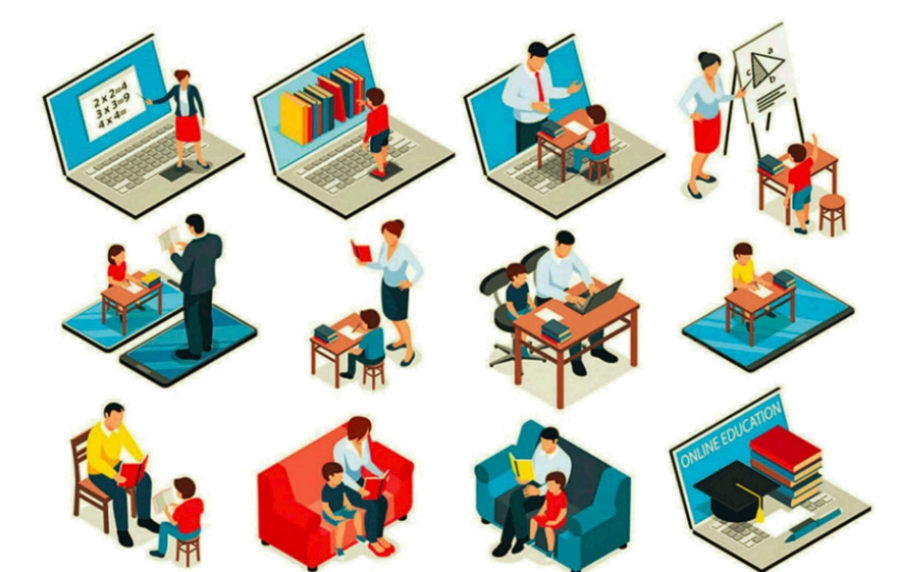National
Parents welcome government decision to introduce several alternative learning platforms
The decision comes as all students do not have internet service at their homes to access online classes.
Aditi Aryal
It has been almost seven months since Pooja KC’s children last went to school. When their school shut down in March as part of the government measure to contain the Covid-19 pandemic, KC was told that classes will be held online. But the school stopped its virtual classes within a month.
KC’s children, aged 14 and 9, attend a small private school in Baluwatar, Kathmandu.
“The parents were told that the school was unable to provide online classes because the attendance was very low,” KC told the Post. “Most families that study in the school are not well off and cannot afford separate devices to give to the kids. Even in our family, we have one smartphone and one tablet and during the few weeks that the classes were held, it was really difficult for us to manage.”
Anju Shrestha, another parent of an eight-year-old girl, said her daughter could not attend online classes since the school did not offer the service for students below grade five.
While Shrestha is at her job at a department store, she leaves her daughter with her neighbours. The child spends most of her afternoon watching TV at the neighbour’s.
In June, Shrestha even tried to follow the virtual learning sessions aired on NTV Plus, but her daughter would not watch them.
Both KC and Shrestha told the Post that their children choose to spend their time watching cartoons on TV, playing games on mobile phones, or venturing outside to play with other kids in the neighbourhood instead of studying.
Both the mothers are worried about their children contracting the coronavirus. On the other hand, they are also torn between having to decide whether to let the children spend their time in front of a screen for the entire day or to allow them to step outside.
“I’ve tried everything from being hard on her to dealing with extreme patience but she refuses to study. Unless there’s a teacher breathing down their necks, kids just won’t listen,” Shrestha said.
Last week, the government came up with a directive that enables local governments to manage teaching-learning activities. Under this directive, students will be classified in five categories based on their access to remote learning platforms such as TV, radio and internet, and the classes would be conducted accordingly.
According to Tarapati Kharel, acting education officer at the Kathmandu Metropolitan City, the education department of the city office is presently in the process of categorising the students.
Kharel told the Post that all students will be able to avail learning opportunities within a few weeks.
So far, there has not been any effective education programme for children who have been out of school for months.
“We tried to provide online classes from Nandi Secondary School,a public school at Naxal, Kathmandu, but the turnout was very low,” Bharat Lal Shrestha, ward chair of Kathmandu Metropolitan City-1, said.
He is now of the view that only those students who take education seriously enrol in online classes.
Like Nandi Secondary School, other schools are also facing the problem of low attendance.
Prithvi Narayan Secondary School at Goldhunga has been providing online classes for the students from the fourth grade onwards, but the attendance rate of students remains poor.
“On a good day, the attendance rate is about 60 percent,” Madhu Aryal, a teacher at the school, told the Post. “We also have students who need to share one device between siblings and we’ve tried our best to accommodate them, but the main issue is the lack of internet subscription.”
According to Aryal’s experience, it has been difficult to adapt to e-learning for both teachers and students in the absence of a physical classroom environment.
“Initially the students were attentive and listened to what was taught but now they turn their videos off and do not participate in class,” he said.
Then there is also the technical issue. Most schools use Zoom, an online meeting platform, to conduct classes. However, since all schools do not have subscriptions, the free calling facility using a trial account automatically terminates the call every 40 minutes.
These interruptions disrupt the teaching-learning activities.
“I decided to discontinue online classes for both my children because they were not learning effectively,” Reshma Shahi, a parent, told the Post.
Since Shahi’s phone did not support Zoom, she was told by the school to purchase a new phone so that they could attend the online classes.
“The teachers kept texting my kids all day and sometimes even late at night,” Shahi said, admitting that she grew concerned given the number of hours her kids were spending online. “The internet could be a dark place if the children are left unsupervised for a long time. They were also getting increasingly anxious with the amount of messages they received, and they admitted to not learning much in these classes. So, I discontinued the online classes.”
Parents like Shahi have welcomed the government’s decision to teach students on various alternative platforms.
“I have been homeschooling my children these days. We haven’t been able to buy textbooks this year, so I am teaching them from their old textbooks. At this time, new learning content would be beneficial for my children,” Shahi said.




 21.02°C Kathmandu
21.02°C Kathmandu













